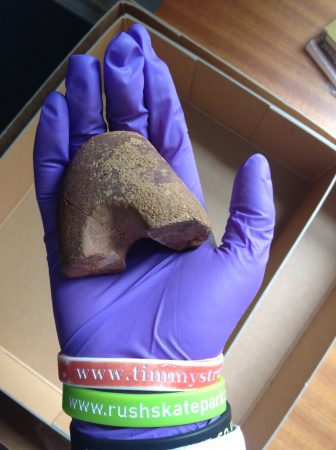Kelly Daye is a student from Deer Park school who has spent the week with us here at the Corinium Museum on work experience. He has taken part in a variety of tasks throughout the week, one of which was to spend the day Resource Centre in Northleach, cataloguing and helping to identify pre-historic artefacts. At the Resource Centre, Kelly and James (Collections Officer at the Museum) came across quite a unique and spectacular artefact. Below is 15 year old Kelly’s impressive blog entry:
Whilst searching through a box of flint and pottery, our intention being to find an arrowhead or a knife; James and I came across a reasonably large rounded stone, which I had previously discarded due to its irrelevance to our search and also due to the angle it was initially at. Fortunately, James took the time to have a look at the stones shape and details and we were both especially excited when discovering what it really was!
Although it had unfortunately been broken into two smaller pieces, and not being in its entirety to begin with, it became clear that it was in fact a stone mace-head from the Neolithic period. A natural pebble which had been drilled into from opposite sides to create a hole in the centre in which a stick would be forced in and it would be used like a hammer. There is clear evidence on the stone’s surface that it had previously been used, such as the wearing on the nose, likely caused by repeatedly striking it against another object.
James, myself and the rest of the staff here at the Corinium Museum are still in debate as to whether the artefact should officially be named a mace or hammer, as there is actually no evidence to say it had been used in combat, whereas the wearing on the nose suggests it was likely used as a tool.
Be sure to keep an eye on the changes around the Museum over the next two years as once the pre-history gallery is updated you may well see this truly spectacular artefact on display, as it is the only one of its kind that the Museum owns.











